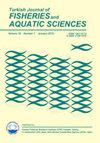Antimicrobial Peptides from fish: Main Forces for Reducing and Substituting Antibiotics
IF 1.5
4区 农林科学
Q3 FISHERIES
引用次数: 0
Abstract
Fish antimicrobial peptides (AMPs) are small molecular peptides with biological activity that play an important role in the fish immune system. They not only have broad-spectrum activity against a variety of viruses, bacteria, fungi, parasites, and cancer cells but also show immunomodulatory activity in different fish. However, the defects of natural fish AMPs, such as their high hemolytic activity and low stability, hinder their application. Therefore, many scientists have tried to optimize the sequence and structure of fish AMPs to meet actual clinical needs. In addition, as the most promising alternative to antibiotics, fish AMPs have good application prospects in animal husbandry, food, biomedicine, and other fields. Many fish AMPs are being researched and developed by scholars around the world. This paper summarizes literature reports regarding the classification of antibacterial peptides and their biological functions and applications, emphasizing their transformation and optimization and the latest research progress to provide a theoretical basis for the research and development of antibacterial peptides as well as technical support for the production of related products.鱼类抗菌肽:减少和替代抗生素的主要力量
鱼类抗菌肽(AMPs)是一种具有生物活性的小分子肽,在鱼类免疫系统中发挥重要作用。它们不仅对多种病毒、细菌、真菌、寄生虫和癌细胞具有广谱活性,而且在不同的鱼类中表现出免疫调节活性。然而,天然鱼类抗菌肽溶血活性高、稳定性低等缺陷阻碍了其应用。因此,许多科学家试图优化鱼类AMPs的序列和结构,以满足实际临床需求。此外,鱼类抗菌肽作为抗生素的最佳替代品,在畜牧、食品、生物医药等领域具有良好的应用前景。世界各地的学者正在研究和开发许多鱼类amp。本文综述了抗菌肽的分类及其生物学功能和应用方面的文献报道,重点介绍了抗菌肽的转化优化和最新研究进展,为抗菌肽的研究开发提供理论依据,为相关产品的生产提供技术支持。
本文章由计算机程序翻译,如有差异,请以英文原文为准。
求助全文
约1分钟内获得全文
求助全文
来源期刊

Turkish Journal of Fisheries and Aquatic Sciences
FISHERIES-MARINE & FRESHWATER BIOLOGY
CiteScore
3.10
自引率
0.00%
发文量
43
审稿时长
3 months
期刊介绍:
Turkish Journal of Fisheries and Aquatic Sciences" (TrJFAS) is a refereed academic journal has been published by Central Fisheries Research Institute of Turkey and Japan International Cooperation Agency (JICA), and published in English.
It aims to address research and needs of all working and studying within the many varied areas of fisheries and aquatic sciences.
The Journal publishes English language original research papers, critical review articles, short communications and technical notes on applied or scientific research relevant to freshwater, brackish and marine environments.
TrJFAS was published biannually (April & November) between 2001 and 2009. A great number of manuscripts have been submitted to the journal for review from acceptance of the SCI index. Thereby, the journal has been published quarterly (March, June, September and December) from 2010 to 2017. The journal will be published monthly in 2018.
 求助内容:
求助内容: 应助结果提醒方式:
应助结果提醒方式:


